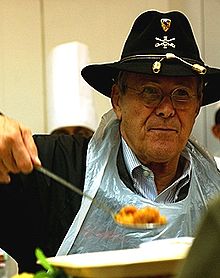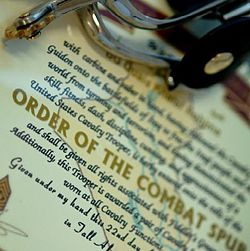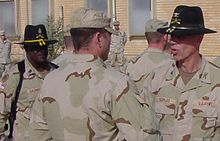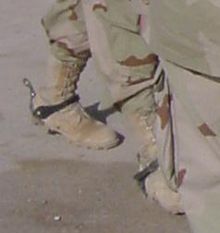- Order of the Spur
-
For the Papal chivalric order, see Order of the Golden Spur.For the related tradition of the stetson, see Cavalry stetson.
Order of the Spur
Certificate for induction into the Order of the Spur for combat action in Tal Afar, Iraq.Awarded by United States Cavalry Type Order Eligibility Military, foreign military, and civilian personnel. Awarded for Completion of a spur ride or combat service in a cavalry unit. Status Currently awarded Statistics First awarded Unknown Last awarded On going The Order of the Spur is a Cavalry tradition within the United States Army. Soldiers serving with Cavalry units (referred to as Troopers) are inducted into the Order of the Spur after successfully completing a "Spur Ride" or for having served during combat as a member of a Cavalry unit. Traditionally, each Trooper is presented spurs by his sponsor at a ceremonial dining in commonly referred to as the "Spur Dinner". The spurs are to be worn with the military uniform during Squadron or Regimental ceremonies and events or as designated by the Cavalry unit commander. In some units, gold spurs are awarded for combat inductions while silver spurs represent having completed the Spur Ride. Within the tradition, silver spurs and gold spurs hold a similar relationship for the cavalry as the Expert Infantryman Badge and the Combat Infantryman Badge hold in the Infantry. There is no Military Occupational Specialty (MOS) requirement for the Order of the Spur and the order is open to members of foreign militaries serving with U.S. Cavalry units.
Contents
History
The tradition of having to "earn your spurs" reaches back to the beginning of the cavalry. When green Troopers first arrived at their new cavalry assignments they were assigned a horse with a shaved tail. This led to the nickname "Shave Tail" for newly assigned, spur-less Soldiers. These new Troopers were in need of extensive training, especially in the area of swordsmanship from atop a horse. The horse with a shaved tail was given extra space in which to operate since its rider was marked as an amateur. During this phase of training the Troopers were not allowed to wear spurs because this would only serve to compound their problems. Only when they were able to prove their ability to perform with their horse and saber were they awarded spurs.
 A spur holder with the U.S. 4th Cavalry Regiment instructs candidates on the assembly of an M2 Browning machine gun after their first try during a 2006 spur ride.
A spur holder with the U.S. 4th Cavalry Regiment instructs candidates on the assembly of an M2 Browning machine gun after their first try during a 2006 spur ride.
Spur Ride
The Spur Ride is the only means of joining the Order of the Spur, aside from a wartime induction. The Spur Ride is an event normally held over multiple days[1] during which a Trooper must pass a series of physical and mental tests that evaluate leadership, technical and tactical proficiency, and the ability to operate as part of a team under high levels of stress and fatigue, under both day and night conditions. A written test is often administered, with questions that cover United States Cavalry and unit history. During the Spur Ride, candidates will be required to recite from memory the traditional cavalry poem, "Fiddler's Green", or other traditions or historical information pertaining to the Cavalry.
The criteria for participation in the Spur Ride are set by each Cavalry unit, usually at the Squadron level. Many units require demonstrated leadership ability through planning and conducting unit-level training events such as gunnery ranges, soldier task training or other NCO/Officer-level tasks. Some examples of minimum criteria are:[verification needed]
- Score a minimum of 250 on the Army Physical Fitness Test (APFT).
- Meet height and weight requirements of AR 600-9.
- Qualify "Expert" with primary weapon (M9 or M16/M4).
- Be recommended by Troop First Sergeant and Commander.
Upon successful completion of the Spur Ride, new spur holders are welcomed with a formal induction ceremony. The ceremony is a dining in, called the Spur Dinner, that often includes other military traditions such as honoring lost comrades, a ceremonial punch[1] (called a grog), and a roll call of the successful candidates. Some units also hold a "hero's breakfast" immediately following the end of the Spur Ride. During the breakfast, the unit commander presents a toast welcoming the successful candidates to the brotherhood prior to the formal induction ceremony.
Regulations
The U.S. Department of the Army classifies the Order of the Spur as an Army tradition, so regulations for induction into the Order of the Spur and the wear of cavalry accoutrements are set by each cavalry unit commander. Lacking any Army-wide regulations, some standards differ from unit to unit, but the tradition remains the same. What follows is one example of a Cavalry Squadron's policy on the wear of Stetsons and Spurs:
- Wear of Cavalry Stetson and Spurs
- a. Field Grade Officer: Solid Gold
- b. Company Grade Officer: Gold and Black
- c. Warrant Officer:
- (1)CW4,CW5 - Solid Silver
- (2)WO1,CW2,CW3 - Silver and Black
- d. Non-Commissioned Officer: Yellow
- (1) The nape strap will be threaded through the appropriate eyelets in the brim of the Stetson so that strap goes around the back and the buckle is fastened and centered on the wearers head.
- (2) The sides of the crown shall not be pushed in or otherwise modified. The brim will be flat with a slight droop at the front.
- (3) The Stetson will be worn on the head with the brim parallel to the ground.
- (4) Occasions for wearing the stetson: Squadron dining-ins/outs, formal events in dress blues, gatherings of spur holders, professional gatherings such as AAAA and any other event or function as designated by Saber 6.
- a. Low Quarters: The spurs will be affixed to the footgear midway between the upper portion of the sole and the lower part of the heel along the seam of the shoe. The U shaped portion shall enclose the shoe in such a manner as to assure that the rowel of the spurs curves down to the ground. The strap will be fastened over the instep of the footgear in such a manner that the buckle faces to the outside of the foot.
- b. Boots: The spurs will be affixed to the footgear so that the U shaped portion follows the seam of the ankle support. The strap will be fastened over the instep of the footgear in such a manner that the buckles face the outside of the boot.
- c. Single Soldiers will wear the rowels of their spurs pointing up, while married Soldiers will do so with their rowels pointing down.
 Former Secretary of Defense Donald Rumsfeld serves Christmas Eve chow to Soldiers deployed to Baghdad, Iraq. In place of rank, the secretary had a 1st Cavalry Division DUI pin.
Former Secretary of Defense Donald Rumsfeld serves Christmas Eve chow to Soldiers deployed to Baghdad, Iraq. In place of rank, the secretary had a 1st Cavalry Division DUI pin.
Department of the Army Regulations
While the regulations governing the order of the spur are set by each cavalry commander (and so do not appear in the Army Regulation governing wear and appearance of uniforms and insignia), the practice falls under what the Army officially recognizes as a tradition. The following is from Field Manual 7-21.13 (The Soldier's Guide, dated 15 OCT 2003):
-
- TRADITIONS
- 4-25. Tradition is a customary pattern of thought, action, or behavior held by an identifiable group of people. It is information, beliefs, and customs handed down by word of mouth or by example from one generation to another without written instruction. Our military traditions are really the "Army Way" of doing and thinking. An interesting thing about traditions is that many of our Army traditions started out as something quite different from what they are now.
- 4-26. Military tradition is an interesting and often amusing subject. It gives a Soldier a feeling of pride to understand just why we do things the way we do. Traditions are expressed in the things we do, the uniform we wear, and the things we say. Many of the words we use in the Army are unique and have been added to our vocabulary from different parts of the world and at different times in history.
- 4-27. Army traditions are the things that everyone in the Army does, everywhere. Unit traditions are the unique things that you do in your unit that other units may or may not do. Some unit traditions are—
-
- Ceremonial duties. Soldiers of the Old Guard, the 3d U.S. Infantry, have been Sentinels of the Tomb of the Unknown Soldier since 1948.
- The green berets of the Army's Special Forces.
- Airborne units’ maroon beret.
- Cavalry units’ spurs and hats. [Bold added]
- Special designations (authorized unit nicknames) such as Cottonbalers, the 7th Infantry Regiment.
- Distinctive items of clothing worn in your unit such as headgear, belt buckles, and tankers' boots.
- The promotion party.
- Unit mottoes such as "Victory!" or "Send me!"
- "Hooah!" This informal but always understood sound is less a word than an audible affirmation of the warrior ethos. The Soldier that utters that sound understands his task and will not quit until it is completed. That sound means Soldiers are ready and willing to accomplish the mission at hand.
See also
- Stetson
- Combat Cavalry Badge
References
- ^ often Friday to Sunday morning
- ^ cjenkins (user name). "Wear of the Cavalry Accouterments" 1 June 1997. [personal website] www.mindspring.com. Accessed 24 February 2008.
- http://www.cavhooah.com/spurs.htm A site about spurs in the Cavalry.
Categories:- Awards and decorations of the United States Army
- Military uniforms
Wikimedia Foundation. 2010.



